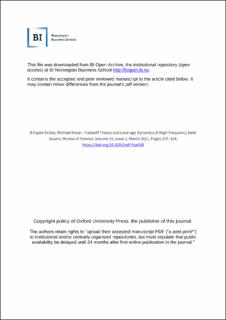| dc.contributor.author | Eckbo, B. Espen | |
| dc.contributor.author | Kisser, Michael | |
| dc.date.accessioned | 2021-11-19T13:46:58Z | |
| dc.date.available | 2021-11-19T13:46:58Z | |
| dc.date.created | 2020-09-24T11:53:24Z | |
| dc.date.issued | 2020 | |
| dc.identifier.citation | Review of Finance, Volume 25, Issue 2, March 2021, Pages 275–324, | en_US |
| dc.identifier.issn | 1572-3097 | |
| dc.identifier.uri | https://hdl.handle.net/11250/2830518 | |
| dc.description.abstract | We test whether high-frequency net-debt issuers (HFIs)—public industrial companies with relatively low issuance costs and high debt-financing benefits—manage leverage toward long-run targets. Our answer is they do not: (1) the leverage–profitability correlation is negative even in quarters with leverage rebalancing; (2) the speed-of-adjustment to target leverage deviations is no higher for HFIs than for low-frequency net-debt issuers; and (3) under-leveraged HFIs do not speed up rebalancing activity in significant investment periods. Thus, even in the subset of firms most likely to follow dynamic trade-off theory, the theory does not appear to hold. | en_US |
| dc.language.iso | eng | en_US |
| dc.publisher | Oxford Uni. Press | en_US |
| dc.subject | G32 - Financing Policy | en_US |
| dc.subject | Financial Risk and Risk Management | en_US |
| dc.subject | Capital and Ownership Structure | en_US |
| dc.subject | Value of Firms | en_US |
| dc.subject | Goodwill | en_US |
| dc.title | Tradeoff Theory and Leverage Dynamics of High-Frequency Debt Issuers | en_US |
| dc.type | Journal article | en_US |
| dc.type | Peer reviewed | en_US |
| dc.description.version | acceptedVersion | en_US |
| dc.source.pagenumber | 275–324 | en_US |
| dc.source.volume | 25 | en_US |
| dc.source.journal | Review of Finance | en_US |
| dc.source.issue | 2 | en_US |
| dc.identifier.doi | 10.1093/rof/rfaa018 | |
| dc.identifier.cristin | 1832958 | |
| cristin.ispublished | true | |
| cristin.fulltext | postprint | |
| cristin.qualitycode | 2 | |
